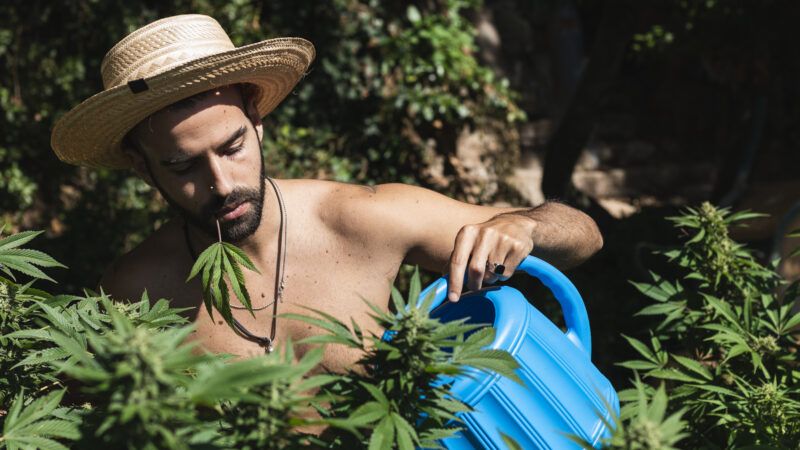Mandating Indoor Cannabis Cultivation Is Bad for the Environment
Legalizing interstate sales and allowing outdoor growing would reduce the cannabis industry's energy consumption.

A new study published this week in the journal Nature Sustainability is critical of the U.S. cannabis industry's significant carbon footprint and contribution to greenhouse gas (GHGs) emissions and climate change.
As one might expect, a study on cannabis and climate change caught the attention of the media. Predictably, too, some headline writers largely—or even entirely—missed what I think is the key point of the study. That key point is the word indoors, which appears right in the title of the study: The Greenhouse Gas Emissions of Indoor Cannabis Production in the United States, by three researchers at Colorado State University. Indeed, while the report takes aim at large, energy-intensive, indoor, warehouse-style cannabis cultivation, it also highlights more sustainable ways to grow cannabis: both outdoors and in greenhouses.
"Their research shows that U.S. indoor cannabis cultivation results in life-cycle greenhouse gas emissions of between 2,283 and 5,184 kilograms of carbon dioxide per kilogram of dried flower," a CSU report on the study details. The study looks beyond mere electricity use from indoor cannabis growing operations to highlight holistic data on GHGs from "other energy sources, such as natural gas, upstream GHG emissions from the production and use of material inputs, and downstream GHG emissions from the handling of waste." Other data the researchers crunched includes water and fertilizer use; heating and air conditioning; grow lights; transportation; CO2 emissions and sequestration; vent fans; heaters; nutrients; and soil.
The energy demands of indoor growing are not exactly breaking news. Commentators have long argued that the cannabis industry can and should adopt more sustainable approaches. A report last year indicated the environmental benefits of growing cannabis outdoors, including the fact that it's easier, more cost-effective, uses less electricity, and produces less waste.
Why aren't more commercial growers cultivating outdoors? It's because a tangle of federal, state, and local laws make doing so legally impossible in many places. Before cannabis was legalized in a handful of states earlier this century, federal, state, and local bans on cultivating cannabis long forced growers indoors.
"Indoor growing helped avoid law enforcement, opening new possibilities for innovation and technological advancement," Green Entrepreneur noted last year. "At the same time, indoor cultivators realized they could grow cannabis with increased control, vigor, and specificity."
But even in those states where cultivating, selling, buying, and using commercial (along with medical) cannabis is now legal, many growers still raise their plants indoors. In many cases, regulations are to blame.
The study authors rightly argue that the "high energy consumption of cannabis is due in part to how the product is regulated," citing rules, such as some found in Colorado, that require grow operations to be securely enclosed and located at or near the point of sale.
"The initial amendment legalizing recreational cannabis in Colorado required the majority of cannabis product to be sold at a collocated retail location," the study notes. "This restriction led to cultivation practices occurring within the city limits of Denver, Colorado. This, along with security, theft and quality concerns, consequently led to the cultivation of cannabis indoors."
"Even if growers wanted to venture outdoors, many local governments in densely populated areas, like the City of Denver's, ban outdoor operations," Westworld reported in 2017. In other words, Denver requires cannabis sold in Denver to be grown in Denver. Just not outdoors.
In some states where cannabis is legal to use, laws discourage more sustainable growing practices. For example, in Washington State, where I live, cannabis use is legal. But state law does not allow anyone except licensed commercial growers to cultivate cannabis.
Commercial cannabis regulations in other states suffer from these and other shortcomings.
Sacramento County, California, bans outdoor cultivation. The city of Fresno does, too. An ordinance in Huntington Beach, California, requires that all commercial cannabis grown in the city must be raised "in appropriately secured, enclosed, and ventilated structures, so as not to be visible to the general public."
In a 2019 piece, a Forbes writer noted that "some current building and energy codes actually force indoor growers to use more energy than necessary."
The interplay of state and federal laws also contributes greatly to the problem.
Take three states that recently legalized cannabis. While New Jersey's climate is conducive to outdoor growing operations, two other states—Montana and South Dakota—offer a less hospitable growing seasoned, Marijuana Business Daily reported after the November elections. The federal prohibition of cannabis means that cannabis may not be transported across state lines, and that means all cannabis that's going to be sold legally in a state must be grown in that state. In a place where the outdoor growing season is short, the prohibition of interstate sales needlessly promotes indoor growing. If we treated cannabis like other agricultural products, states like Montana and South Dakota could grow outdoors in the summer and buy from other states in the colder months.
None of this is to say that growing cannabis outdoors is a slam dunk. It carries most of the same risks as any other outdoor crop production, including drought, flooding, other severe weather, pestilence, natural disasters, and theft and other security risks. Outdoor growing may also require the application of additional pesticides.
My point isn't that growing cannabis outdoors is the only way it can or should be done. Rather, growers of cannabis—just like growers of lettuce or beans—should be allowed to choose the place and methods of cultivation they want to use.
I wrote a whole book about ways that federal, state, and local regulations often promote unsustainable food and agricultural practices over more sustainable ones. Growing cannabis can be done sustainably. If only the law would allow for it.


Show Comments (111)